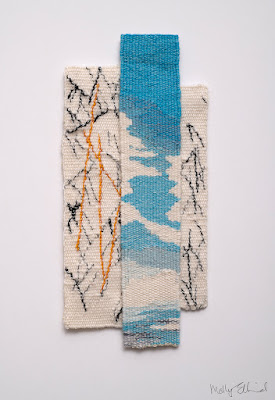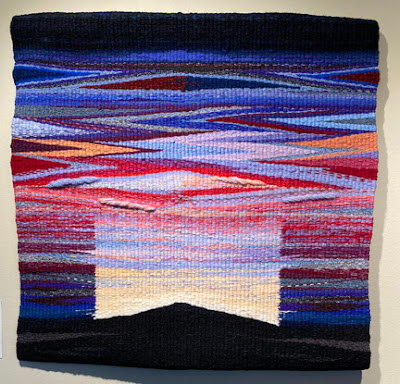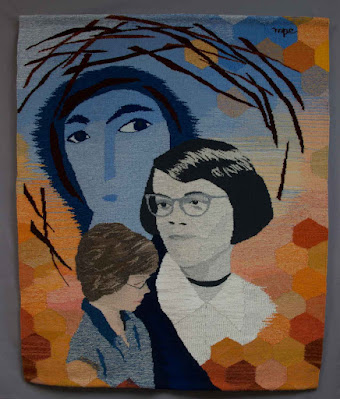In my last post I described my plan to launch online Feedback Groups, small groups of five or six tapestry weavers who would share their work, troubleshoot problems, and give and receive feedback. These are not formal classes; I'm just facilitating discussion and providing pointers. I am thrilled to say that I have two full groups scheduled to meet starting in January 2022, and I'm taking names for a third group that I will form a bit later. Contact me if you'd like to be on that list.
One of the first things we will try is a method for looking at, understanding and evaluating art that I learned years ago when I did some work in museum education. It's a four-step process that I have talked about in my classes and in local tapestry groups and I've seen the lightbulbs go off above people's heads many times! It really does work to help you understand and appreciate professional works of art you might see in a museum . . . and pieces your fellow weavers do . . . and your own work.
So here are the steps, as they might play out in response to one of my own pieces. Since I wove this tapestry over three years ago, I hope I have enough distance on it to be somewhat objective.
1: Describe what you see, in neutral (not judgmental) terms. To do this, you first have to slow down (stop scrolling on Instagram, or if you're in a museum or gallery, stop walking) and really look at the work. Then, instead of jumping to the conclusion that you like or don't like the work (as we so often do), instead, describe to yourself or your companion what you see. What is happening? How would you describe the figures, shapes, objects, textures, colors etc.? Again, the point is simply to describe, not to express approval or disapproval at this point.
 |
| Molly Elkind, Red Letter Night, 35" x 26", cotton, wool, silk, blends, 2018 |
2: Analyze. How do the things you see and describe relate to each other in the work?
The mostly dark background is enlivened by the lighter pink stripes and the diagonal lines create a feeling of movement behind the large stationary shapes. The lighter stripes relate to the color of the largest shape. The curvilinear pattern in the yellow-green rectangle seems unrelated to other patterns in the piece. The urn shape also feels different, because it is not touching any other shapes and is mostly curved.
3. Interpret. How do the things you see create a mood, feeling or idea in you, the viewer? What impact does the piece have on you? Why do you think the artist chose these materials and techniques?
The dark red parallel lines in that shape remind me of lines of text. The way three of the shapes are layered suggests a collage of separate shapes. They form an area of pattern that stands out against the quieter pattern of the background. The urn shape balances out the composition but it's unclear what its purpose is. The entire piece remains mysterious in its meaning.
4. Evaluate. Does the piece succeed in what you think it's aiming to do? Do you like it? Would you like to see more work by this artist?
I think this piece is partly successful. One of my technical goals was to see if I could successfully combine wedge weave and plain weave in the same tapestry, and that seemed to work pretty well. I also wanted to translate a small paper collage into a large woven piece, and I think that translation was successful. I struggled with how to render the swirling parallel lines of the collage background in tapestry, finally deciding to "paraphrase" them into wedge weave rather than try to literally reproduce them. I used silk for the blue shape and some stainless steel yarn in the small red shape, and they provided some interesting contrast in terms of sheen.
 |
| Molly Elkind, paper collage, 12" x 9", commercial and handmade, hand-printed papers, 2018 |
At the time I was working on a series inspired by medieval illuminated manuscripts, interested in how brightly colored and densely patterned areas in the center of the "page" contrasted with plainer backgrounds. I had also just been to Istanbul and was enthralled with arabesque lines and shapes, hence the blue urn shape. The piece was planned as a companion to a tapestry of the same size called Red Letter Day.
 |
| Molly Elkind, Red Letter Day, 35.5" x 26", cotton, wool, synthetic, 2016 |
However, Red Letter Night remains opaque in its intention. The reference to illuminated manuscripts is not obvious to most. Looking at it now, the large pink trapezoid seems arbitrary and rather clumsy to me. If I were to do it over, I might adjust that shape instead of following the original collage so closely.
I hope this exercise in looking and evaluating has been useful for you. For me, the key parts of this process are at the beginning and at the end. First, you withhold judgment in an attempt simply to spend time looking, really looking at the work. Then, when you finally do allow yourself to make an evaluation at the end, you know you're basing it on a careful effort to understand the work on its own terms. This is critical: just as we ourselves don't like to be judged by standards that we don't agree with, so we shouldn't judge artwork by standards that are irrelevant to the work at hand.
The question is not, "is this work of art good or bad?"; the question is, "does it succeed on its own terms?" This is a hugely different question!

















































